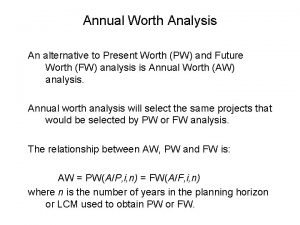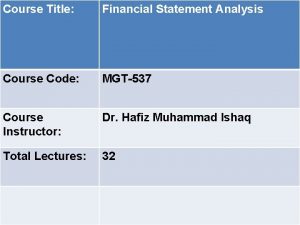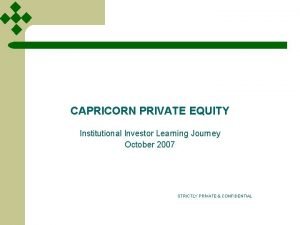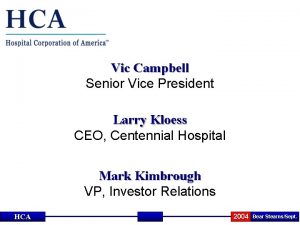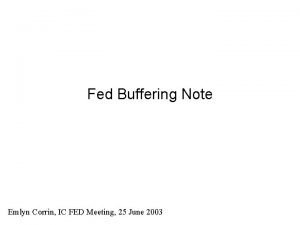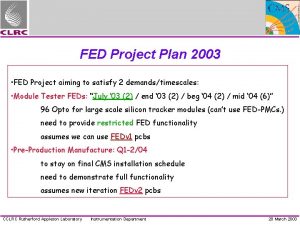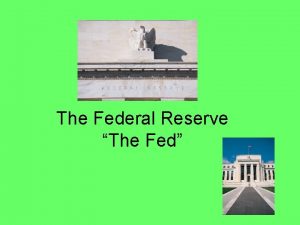FED RETURN ONTAPERING NET WORTH Return on Net















- Slides: 15

FED RETURN ONTAPERING NET WORTH

Return on Net Worth – By Prof. Simply Simple™

RETURN ON NET WORTH q Return on Net Worth (RONW) is used in finance as a measure of a company’s profitability q It reveals how much profit a company generates with the money that the equity shareholders have invested q Therefore, it is also called ‘Return on Equity’ (ROE) q This ratio is useful for comparing the profitability of a company to that of other firms in the same industry

RETURN ON NET WORTH Return on Net Worth (RONW) q It is expressed as: RONW = Net Income ---------------------Shareholder’s Equity X 100 q The numerator is equal to a fiscal year’s net income (after payment of preference share dividends but before payment of equity share dividends) q The denominator excludes preference shares and considers only the equity shareholding

RETURN ON NET WORTH Example… q A company’s net income for the year was Rs. 60, 000 and shareholder equity for the year was Rs. 3, 000 q This gives us a Return on Net Worth of 20% (Rs. 60, 000 net income / Rs. 3, 000 shareholder equity) q This means that for each rupee invested by shareholders, 20% was returned in the form of earnings q So, RONW measures how much return the company management can generate for its equity shareholders

RETURN ON NET WORTH Therefore… q RONW is a measure for judging the returns that a shareholders gets on his investment q As a shareholder, equity represents your money and so it makes good sense to know how well management is doing with it. q Last week, we spoke about Return on Capital Employed (ROCE) which is a way of assessing a company’s profitability from its overall operations q Let us now try to understand how RONW is a more appropriate tool for decision making than ROCE

Difference between Return on Capital Employed (ROCE) and Return on Net Worth (RONW)

RETURN ON NET WORTH Example of ROCE… q A and B both started a business by investing initial capital of Rs. 10, 000 each q After one year, A had an after-tax profit of Rs. 4, 000 while B made only Rs. 3, 000 q The return on capital employed for A was 40% (Rs. 4, 000 / Rs 10, 000) while for B it was 30% (Rs. 3, 000 / Rs 10, 000) q On the face of it, it appears that A was the better manager since he earned more profit and therefore a higher return than B – though both started their businesses with the same amount of initial capital

RETURN ON NET WORTH So, therefore as an investor you are likely to feel encouraged to invest in A rather than B

RETURN ON NET WORTH But, RONW says… q Now, assume that A’s business had shareholder equity of Rs. 45, 000 and net income of Rs. 4, 000 q While B’s business had shareholder equity of Rs. 30, 000 and net income of Rs. 3, 000. q RONW of A is Rs. 4, 000 / Rs. 45, 000 = 8. 88% q RONW of B is Rs. 3, 000 / Rs. 30, 000 = 10% q Now, with this measure of RONW, we find that q B has done better than A!

RETURN ON NET WORTH To sum it up… q ROCE considers total capital which is in the form of both equity and long term debt such as loans and borrowings q While RONW considers only equity shareholding as the base for deciding efficiency of a company’s operations q So, for an equity investor, RONW is a better measure of efficiency than ROCE, since he is interested in knowing the return on his equity investment rather than return on the company’s total capital

RETURN ON NET WORTH So…. ROCE is an appropriate measure to get an idea of the overall profitability of the company's operations while RONW is an appropriate measure for judging the returns that a shareholder gets on his investment Hence successful investors like Warren Buffet assign more importance to a company’s RONW to understand their investment growth potential

RETURN ON NET WORTH Hope you have now understood the concept of RONW

Do write to us at – professor@tataamc. com

DISCLAIMER The views expressed in this lesson are for information purposes only and do not construe to be any investment, legal or taxation advice. The lesson is a conceptual representation and may not include several nuances that are associated and vital. The purpose of this lesson is to clarify the basics of the concept so that readers at large can relate and thereby take more interest in the product / concept. In a nutshell, Professor Simply Simple lessons should be seen from the perspective of it being a primer on financial concepts. The contents are topical in nature and held true at the time of creation of the lesson. This is not indicative of future market trends, nor is Tata Asset Management Ltd. attempting to predict the same. Reprinting any part of this material will be at your own risk. Tata Asset Management Ltd. will not be liable for the consequences of such action. Mutual Fund investments are subject to market risks, read all scheme related documents carefully.
 Return on net worth
Return on net worth Anything worth doing is not necessarily worth doing well
Anything worth doing is not necessarily worth doing well Annual worth
Annual worth Annual worth analysis example
Annual worth analysis example Tangible net worth
Tangible net worth High net worth tax planning
High net worth tax planning Greg jarboe
Greg jarboe Capricorn private investments
Capricorn private investments Mark kenyon net worth
Mark kenyon net worth Andrew weinreich net worth
Andrew weinreich net worth Johnny cupcakes net worth
Johnny cupcakes net worth Debbie cooper net worth
Debbie cooper net worth George yang net worth
George yang net worth Mexican posse milwaukee
Mexican posse milwaukee Victor campbell nashville net worth
Victor campbell nashville net worth Tandy trower net worth
Tandy trower net worth



